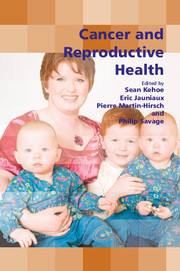Book contents
- Frontmatter
- Contents
- Participants
- Preface
- SECTION 1 Epidemiology, Genetics and Basic Principles of Chemotherapy and Radiotherapy
- SECTION 2 Fertility Issues and Paediatric Cancers
- SECTION 3 Gynaecological Cancers and Precancer
- SECTION 4 Diagnostic Dilemmas
- 13 Imaging techniques
- 14 Serum markers for gynaecological cancer in the reproductive years
- 15 Diagnostic dilemmas in cellular pathology
- SECTION 5 The Placenta
- SECTION 6 Non-Gynaecological Cancers
- SECTION 7 Multidisciplinary Care and Service Provision
- SECTION 8 Consensus Views
- Index
13 - Imaging techniques
from SECTION 4 - Diagnostic Dilemmas
Published online by Cambridge University Press: 05 October 2014
- Frontmatter
- Contents
- Participants
- Preface
- SECTION 1 Epidemiology, Genetics and Basic Principles of Chemotherapy and Radiotherapy
- SECTION 2 Fertility Issues and Paediatric Cancers
- SECTION 3 Gynaecological Cancers and Precancer
- SECTION 4 Diagnostic Dilemmas
- 13 Imaging techniques
- 14 Serum markers for gynaecological cancer in the reproductive years
- 15 Diagnostic dilemmas in cellular pathology
- SECTION 5 The Placenta
- SECTION 6 Non-Gynaecological Cancers
- SECTION 7 Multidisciplinary Care and Service Provision
- SECTION 8 Consensus Views
- Index
Summary
Radiobiology
Ionising radiation in medicine is used in two broad areas, namely diagnostic imaging and radiotherapy, and these are distinguished from each other only in the magnitude of the radiation. There are two types of ionising radiation: particles and electromagnetic radiation. The particles are principally alpha particles (helium nuclei) and beta particles (electrons), whereas electromagnetic radiation used in diagnostic imaging comprises X-rays and gamma rays.
X-rays are characterised by being very penetrative through tissues and have few and well-separated episodes of energy deposition within the tissue. This is known as low linear energy transfer. The harmful effects of radiation are well known from previous high-dose exposures following the atomic bomb detonations in the Second World War and the Chernobyl nuclear power plant accident in 1986. In clinical medicine, the late onset of radiation-induced cancers following therapeutic radiation, for example in the treatment of ankylosing spondylitis, is also well known. Extrapolating from these data of high-dose exposures, it is considered that any dose of radiation may be harmful and that there is no threshold below which radiation may not cause harmful effects. This is known as the linear no-threshold hypothesis, which states that the risk of radiation damage is proportional to the dose received, with no safe threshold.
This model of radiation damage is not universally accepted and other authorities consider that small doses of radiation (such as arising from natural background exposure) of up to 4 millisieverts (mSv) are not associated with an increased risk of cancer induction.
Keywords
- Type
- Chapter
- Information
- Cancer and Reproductive Health , pp. 147 - 154Publisher: Cambridge University PressPrint publication year: 2008



